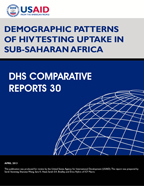- PUBLICATIONS
- JOURNAL ARTICLES
- ORDER PUBLICATIONS
Publications Summary
- Document Type
- Comparative Reports
- Publication Topic(s)
- HIV/AIDS
- Country(s)
- Cameroon, Congo, Ethiopia, Ghana, Kenya, Lesotho, Madagascar, Malawi, Mozambique, Nigeria, Rwanda, Senegal, Tanzania, Uganda, Zimbabwe
- Language
- English
- Recommended Citation
- Staveteig, Sarah, Shanxiao Wang, Sara K. Head, Sarah E.K. Bradley, and Erica Nybro. 2013. Demographic Patterns of HIV Testing Uptake in Sub-Saharan Africa. DHS Comparative Reports No. 30. Calverton, Maryland, USA: ICF International.
- Download Citation
- RIS format / Text format / Endnote format
- Publication Date
- April 2013
- Publication ID
- CR30
Download
 Demographic Patterns of HIV Testing Uptake in Sub-Saharan Africa (PDF, 2508K)
Demographic Patterns of HIV Testing Uptake in Sub-Saharan Africa (PDF, 2508K)
